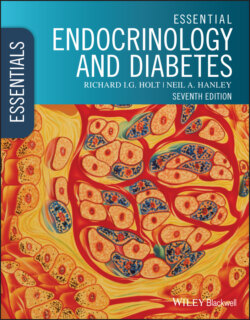Читать книгу Essential Endocrinology and Diabetes - Richard I. G. Holt - Страница 18
The role of hormones
ОглавлениеEndocrine (i.e. hormone‐secreting) cells may exist as distinct glands or be located as single cells within other organs, such as the gastrointestinal tract (Table 1.2). The chapters in Part 2 are largely organized on this anatomical basis.
Hormones act by binding to specific receptors, either on the surface of or inside the target cell, to initiate a cascade of intracellular reactions, which frequently amplifies the original stimulus and generates a final response. These responses are altered in hormone deficiency or excess: for instance, GH deficiency leads to short stature in children, while excess causes over‐growth (either gigantism or acromegaly; Chapter 5).
Table 1.2 The endocrine organs and their hormones*
| Gland | Hormone | Molecular characteristics |
|---|---|---|
| Hypothalamus/median eminence | Releasing and inhibiting hormones: | |
| Thyrotrophin‐releasing hormone (TRH) | Peptide | |
| Somatostatin (SS; inhibits GH) | Peptide | |
| Gonadotrophin‐releasing hormone (GnRH) | Peptide | |
| Corticotrophin‐releasing hormone (CRH) | Peptide | |
| Growth hormone‐releasing hormone (GHRH) | Peptide | |
| Dopamine (inhibits prolactin) | Tyrosine derivative | |
| Anterior pituitary | Thyrotrophin or thyroid‐stimulating hormone (TSH) | Glycoprotein |
| Luteinizing hormone (LH) | Glycoprotein | |
| Follicle‐stimulating hormone (FSH) | Glycoprotein | |
| Growth hormone (GH) (also called somatotrophin) | Protein | |
| Prolactin (PRL) | Protein | |
| Adrenocorticotrophic hormone (ACTH) | Peptide | |
| Posterior pituitary | Vasopressin [also called antidiuretic hormone (ADH)] | Peptide |
| Oxytocin | Peptide | |
| Thyroid | Thyroxine (T4) and tri‐iodothyronine (T3) | Tyrosine derivatives |
| Calcitonin | Peptide | |
| Parathyroid | Parathyroid hormone (PTH) | Peptide |
| Adrenal cortex | Aldosterone | Steroid |
| Cortisol | Steroid | |
| Androstenedione | Steroid | |
| Dehydroepiandrosterone (DHEA) | Steroid | |
| Adrenal medulla | Epinephrine (also called adrenaline) | Tyrosine derivative |
| Norepinephrine (also called noradrenaline) | Tyrosine derivative | |
| Stomach† | Gastrin | Peptide |
| Pancreas (islets of Langerhans) | Insulin | Protein |
| Glucagon | Protein | |
| Somatostatin (SS) | Protein | |
| Pancreatic polypeptide | Protein | |
| Ghrelin | Protein | |
| Small and large intestine† | Secretin | Protein |
| Glucagon‐like peptide 1 (GLP‐1) | Protein | |
| Liver | Insulin‐like growth factor I (IGF‐I) | Protein |
| Ovary | Oestrogens | Steroid |
| Progesterone | Steroid | |
| Testis | Testosterone | Steroid |
* The distinction between peptide and protein is somewhat arbitrary. Shorter than 50 amino acids is termed a peptide in this table.
† The list is far from exhaustive for the gastrointestinal tract (see Chapter 11).
Hormone responses can be widespread or incredibly focussed according to how widely the hormone’s receptor is distributed. For instance, thyroid hormone acts on many, if not all, of the more than 200 cell types in the body. The body’s entire metabolic rate increases if it is present in excess and declines if there is a deficiency (Chapter 8). Similarly, insulin acts on most tissues; an importance underlined by its pivotal role in the survival and growth of many cell types in laboratory culture. In contrast, other hormones may act only on one tissue. For instance, thyroid‐stimulating hormone (TSH), adrenocorticotrophic hormone (ACTH) and the gonadotrophins are secreted by the anterior pituitary and regulate specific cell‐types in the thyroid gland, the adrenal cortex and the gonads, respectively (Table 1.2).
